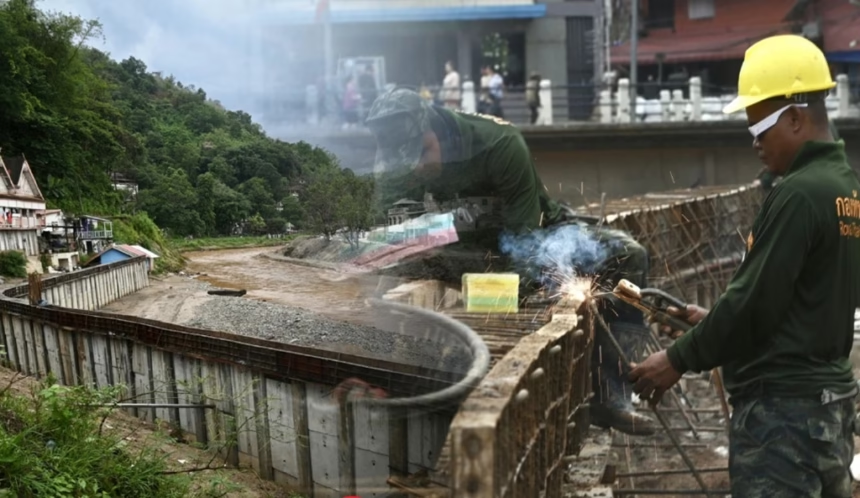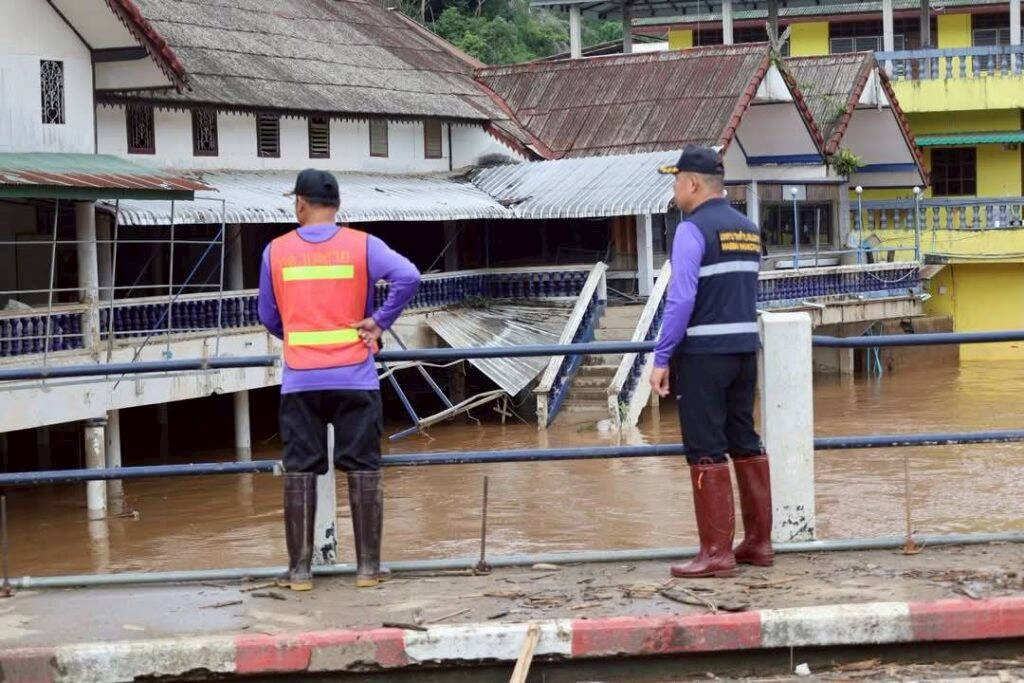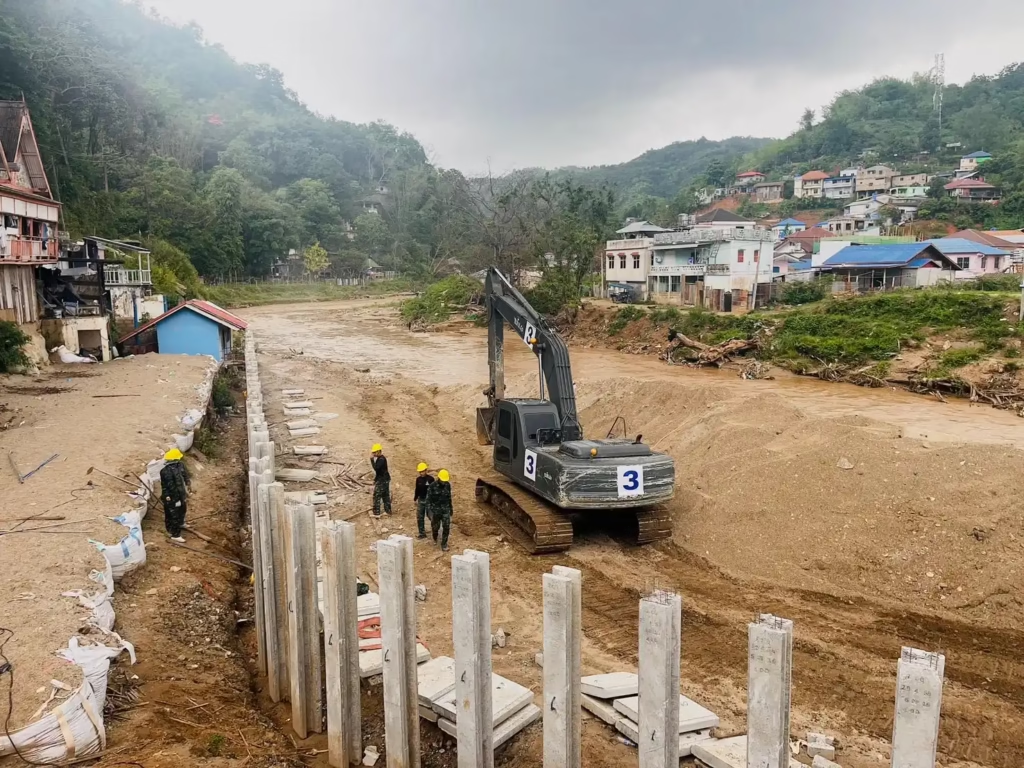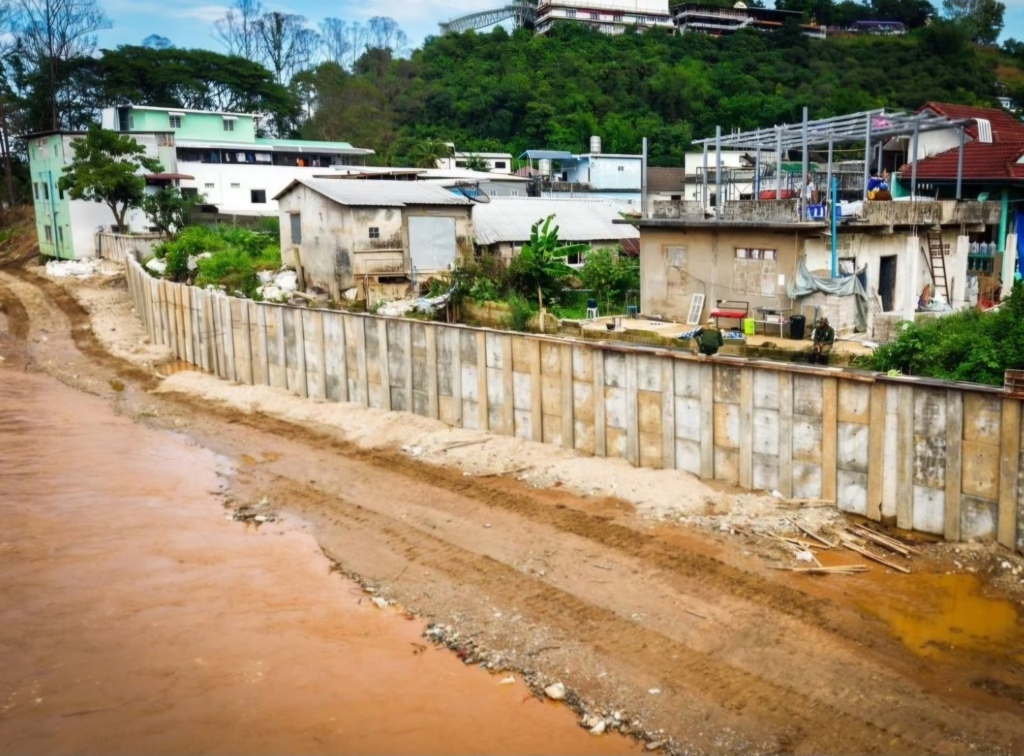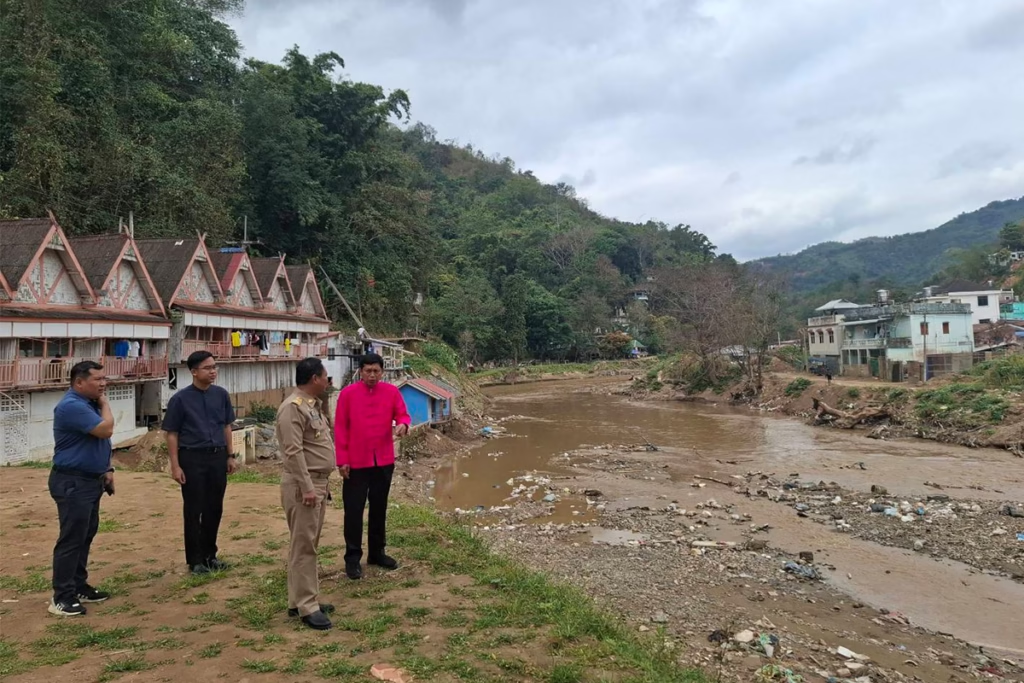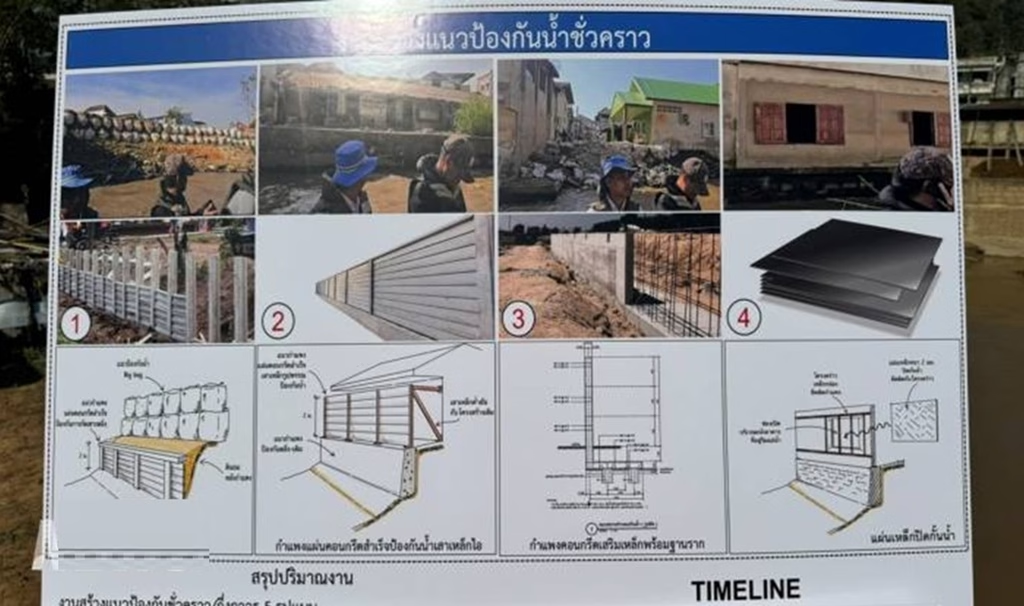CHIANG RAI – The National Human Rights Commission of Thailand visited the Mae Sai district in Chiang Rai. The visit followed complaints from residents affected by flood control works and possible relocations along the Sai River. People asked for clear support measures, since building a flood barrier may require removing homes and moving entire communities.
Siyamol Kaiyurawong, a commissioner, met residents in Ko Sai, Sai Lom Joy Market, and Hua Fai. These areas suffered severe damage in the 2567 floods. The team inspected the big-bag flood line that now affects homes and access to local lanes, then listened to concerns from residents in all three communities.
Officials said the three sites may face demolition and relocation to new areas. The Department of Public Works and Town & Country Planning will run at least three public hearings on the design.
In the afternoon, agencies met at Mae Sai Municipality Hall. Vice Governor Prasong La-orn chaired the meeting. The commission asked both officials and residents to state their views on the next steps.
Engineering Study and Design
Nattapon Tonkaew, a senior civil engineer at the Chiang Rai Provincial Office of Public Works and Town & Country Planning, outlined the study plan. The Cabinet approved a 24 million baht budget to hire a consultant.
The signing is expected in November. The study will address flash floods and mudflows in Mae Sai. It will cover two systems. First, a defence to stop river overflow from reaching the urban and economic zones. Second, new urban drainage to move water out faster.
As of 30 Sept. 2568, the consultant proposed three design options. Each option includes an elevated flood road with a roadway on top. The options share the same protection line, but road layouts vary. In economic areas, there would be both the old and the new roads. Near the second checkpoint, there would be only the existing road.
Officials have mapped all land types in the project area. Parcels with title, without title, state property, and sites of government offices are all identified. The consultant will list the number of homes affected by the flood embankment. Whether to move each home will be decided in the next steps. These ideas are still a draft and will go to local hearings.
Chansom Pentatham, from the Treasury Department’s Chiang Rai office, said 14 riverside tenants agreed to cooperate and have already had leases terminated. About 40 households remain under the study phase. Under state property rules, there is no compensation for tenants on Treasury land, based on lease conditions. Affected tenants can submit requests so the province can compile a database for the study committee.
Forest Land and River Encroachment
Niuwat Miwansuksakul, a senior forestry officer from Forest Resource Management Office 2, said officials have met residents three times. They asked people who built into the river to sign a consent for demolition. Some residents insist on compensation or housing support first. The Forest Department has no regulation to pay compensation for forest land.
Vice Governor Prasong said a full survey found 843 households along the river. Costs per structure have not yet been assessed. The data now covers house counts, addresses, and population only. Compensation procedures will come from the Department of Public Works and Town & Country Planning.
Owners with title may receive land and structure compensation. Those without a title fall under state rules. The details are not yet settled. He added that relocation sites and support must be negotiated with communities.
Lt. Jg. Lopas Amornpalang, a community operations officer at the Community Organizations Development Institute, said disaster agencies funded home repairs after the 2567 floods. Community councils are now mapping affected areas. CODI supports housing for low-income families, including budgets for new builds. The key issue is land for resettlement. People should be able to stay near their work. Any move must be voluntary.
Akkarawin Sawatdee, head of Wiang Pang Kham tobacco leaf station, spoke for the Tobacco Authority of Thailand in Chiang Rai. The station controls about 75 rai near the urban area. The land belongs to the Tobacco Authority of Thailand under the 2561 Tobacco Act, which separated assets from the Treasury Department. The Finance Ministry oversees the Tobacco Authority’s land.
The Highways Department once used part of it for road works. No request for housing use has been made. If the province needs it, it must apply through the Authority’s board.
Semi-Permanent Flood Barriers
Mae Sai District Chief Warayut Khombun said 2567 brought landslides and severe floods. The government built temporary and semi-permanent flood barriers over 3.6 kilometres in Mae Sai and dredged 42 kilometres of the Ruak River. Myanmar dredged 7 percent of its section and then stopped. There is no budget yet for removals or new works. A request has been sent to the province.
If the consultant contract is signed in November, the study will take eight months and should finish by mid-June. Next year’s rains will arrive before long, so Mae Sai could flood again.
Mae Sai Mayor Chaiyon Srisamut said the municipality cannot fund these fixes alone. If talks fail next year and they need to repair big-bag barriers, there is no budget. The district has already notified that no funds are available. During the eight-month study, heavy rain could hit earlier. Other funding sources may be needed.
Noppadon Kantawong, from Ko Sai, said rumours about demolishing buildings caused fear. People worry about where to live and whether there is a plan. Residents want clear, accurate information to feel secure. Many accept the need to move to reduce flood risk in Mae Sai, but they need to know where they will go and if housing will be provided.
Another resident said officials asked seven households to sign a consent for demolition, saying the case would go to the Cabinet. The group was told six or seven houses would not qualify, but ten or more might be considered for compensation. Those who signed still do not know where they will live after the demolition. There is no plan for housing or jobs.
Several residents without land title said they understand state rules on compensation and expropriation. They worry about long timelines. They do not oppose flood works. They want a way to help non-title holders find new homes. That is their biggest concern.
Human Rights Commission’s Views
Commissioner Siyamol said the community relocation is a Public Works and Town & Country Planning project. Government funding of 24 million baht will hire a consultant to run three rounds of public hearings. Designs for flood walls will likely include two or three options. The process must include fair compensation.
During early works, some structures may be removed. The method and timing need careful handling. Some areas are on Treasury land near Sai Lom Joy Market. Areas in front of Ko Sai along the river are forest land under the 2484 Forest Act. Many residents may not know who owns the land. Homes have stood since about 2529. Some buildings may lack permits under the building control law.
She asked the municipality to have engineers check the safety of houses at risk before the next rainy season. Long-term, relocation sites must be identified. The province should propose options to the government. CODI can advise on rules for temporary and permanent housing. Homes will not be given for free. Land would remain state-owned. Residents need clear information to decide whether to move.
On compensation, she said a conciliatory approach can work. Those with land title would fall under expropriation law and receive payment for land and structures, likely near market value, though rates can be lower. Those on Treasury or forest land would receive compensation for removing structures, not for the land. People need to know how much they will receive for removal and agree on the terms. That is key to settling.
The commission will compile all concerns and send them to the Department of Public Works and Town & Country Planning, the government, and Chiang Rai Province. These points should guide the public hearings so that every affected household can make an informed choice.
Proposed Mae Sai Flood Management Options
The consultant has three long-term options to manage flash floods, mudflows, and urban flooding in Mae Sai. Along the north bank of the Sai River, the plan sets a 3.96-kilometre flood and mud barrier. The riverfront would include six landscape zones:
- Community recreation areas that also hold overflow
- A community activity plaza
- Mae Sai cultural plaza with a landmark and parking
- Another community recreation and overflow area
- A garden of ten ethnic groups
- A forest park with a water retention space
Project Scope, Benefits, and Timeline
- Land to be expropriated: 275 rai
- Structures to be removed: 843
- Households benefiting: 16,980
- People benefiting: 35,060
- Estimated losses avoided: over 6 billion baht
- Total project cost: about 3,430 million baht
- Construction: 1,600 million baht
- Compensation and allowances: 1,830 million baht
- Timeline: late 2568 to 2573, about five years
The Department of Public Works and Town & Country Planning will run three public hearings over the next eight months. The final proposal will go to Cabinet after the hearings.




